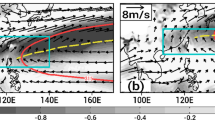Abstract
In this paper, the relation between Asian summer monsoon circulation and sea surface temperature anomalies over equatorial central-eastern Pacific is investigated by using a global spectral model. This model has nine layers in the vertical and the model variables are represented in the horizontal as truncated expansions of the surface spherical harmonics with rhomboidal truncation at wave number 15. The model involves comparatively complete physical processes and parameterizations with mountains.
Using the above model, two experimental schemes are designed, namely control case and anomalous sea surface temperature case. The above two schemes are respectively integrated for forty days and the simulated results are obtained from the last 30-day averaged simulations.
The simulations show that positive SST anomalies over equatorial central-eastern Pacific weakens Indian monsoon circulation, decreases precipitation in Indian sub-continent whereas it intensifies East Asian monsoon circulation and increases precipitation in East Asian area. All these results reflect the characteristics of Asian summer monsoon during the El Nino period. In this paper, SST anomalies over equatorial central-eastern Pacific have a direct influence on the intensity and position of subtropical high via the wave train over Northern Hemisphere, which is similar to that suggested by Nitta(1987) and the wave train over Southern Hemisphere has an influence on the intensity of Mascarene high and Australia high resulting in affecting cross equatorial flow. As a result, atmospheric interior heat sources and sinks are redistributed because of the change of cross equatorial flow. And the response of atmosphere to the new heat source and sink has a significant influence on Asian summer monsoon.
Similar content being viewed by others
References
Chen Lieting, (1987), Zonal anomaly of sea-surface temperature in the tropical India-Pacific Ocean and its effects on summer Asian monsoon,The Proceedings of international conference on the general circulation of East Asia, April 10–15, 1987, 128–139.
Huang Ronghui and Li Weijing, (1987), Influence of the heat source anomaly over the western tropical Pacific for the subtropical high over East Asia,The Proceedings of international conference on the general circulation of East Asia, April 10–15 1987, Chengdu, China, 40–44.
Keshavamurty, R.N., (1982), Response of the atmosphere to sea surface temperature anomalies over the equatorial Pacific and the teleconnections of the southern oscillation,J. Atmos. Sci.,39: 1241–1259.
Krishnamurti, T.N. (1981),Tropical Meteorology, WMO, No. 264.
Ni Yunqi, Qian Yongfu and lin Yuanbi, (1989), The effects of sea surface temperature over the equatorial western Pacific and the Indian Ocean on the Asian summer monsoon,ACTA METEOROLOGICA SINICA,3: No. 3, 375–394.
Ni Yunqi, Qian Yongfu, 1989 (a): The effects of sea surface temperature over the middle latitude western Pacific on the Asian summer monsoon, to be published inACTA METEOROLOGICA SINICA.
NI Yunqi et al., 1989 (b): Generalation mechanism and propagation characteristics of equatorial thermally forced short term climatic oscillation during the Northern summer, to be published inACTA METEOROLOGICA SINICA.
Nitta, T., (1987), Convective activities in the tropical western Pacific and their impact on the Northern Hemisphere summer circulation,The Proceedings of international conference on the general circulation of East Asia, April 10–15, 1987, Chengdu, China, 121–126.
McAvaney, B. J., W. Bourke and K. Puri, (1978), A global spectral model for simulation of the general circulation,J. Atmos. Sci.,35: 1557–1583.
Shukia, J. and J. M. Wallace, (1983), Numerical simulation of the atmospheric response to equatorial Pacific sea surface temperature anomalies,J. Atmos. Sci.,40: 1613–1630.
Wang Jizhi and Li Maicun, (1982), Cross equatorial flow originating from Australia and Monsoonal Circulation of China and Precipitation,Scientia Atmospherica Sinica,6: 1–9.
Webster, P. J. (1981), Mechanisms determining the atmospheric response to sea surface temperature anomalies,J. Atmos. Sci.,38: 1179–1196.
Author information
Authors and Affiliations
Rights and permissions
About this article
Cite this article
Ni, Y., Lin, Y. Numerical study for characteristic change of Asian summer monsoon circulation and its influence mechanism during the El Nino period. Adv. Atmos. Sci. 7, 320–330 (1990). https://doi.org/10.1007/BF03179764
Received:
Issue Date:
DOI: https://doi.org/10.1007/BF03179764




